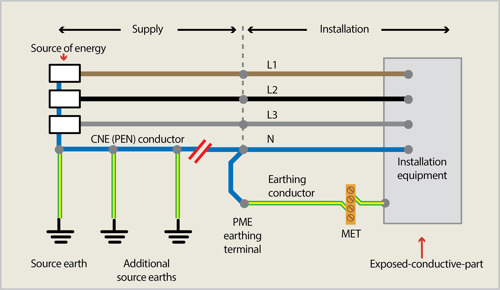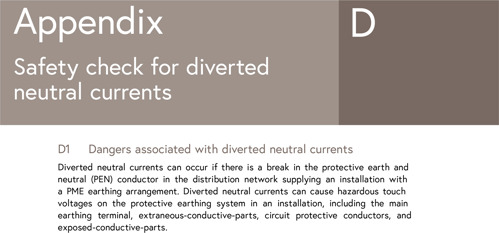
Neutral current diversion (NCD) – industry research
By: Mark Coles
The IET, working with industry partners NICEIC, ECA, Electrical Safety First, NAPIT and SELECT, are reaching out to electrical installers and electrical inspectors for their help in the research of ‘neutral current diversion ’.
There’s not a lot of data available in the public domain but that’s where you come in!
What is neutral current diversion?
In the event of a lost protective earthed neutral (PEN) conductor on a TN-C (PME) electrical supply, the installation loses its intended connection to neutral and Earth. Current is then ‘diverted’ and will find its way back to the supply transformer any way it can. One common route is through shared metallic pipework, such as gas and water pipes.
Before we get ahead of ourselves, let’s look at PEN conductors.
What is a PEN conductor?
A PEN conductor is a single conductor that has the combined function of neutral and protective earth in one conductor of a TN-C low-voltage distribution network. Conventionally, for a three-phase distribution, the cable will be three solid cores, which are L1, L2 and L3, with wire armourings which is the PEN conductor. An example of this type of cable is a concentric cable to BS 7870-3.40 LV and MV polymeric insulated cables for use by distribution and generation utilities - Distribution cables of rated voltage 0.6/1 (1.2) kV. Specification - XLPE insulated, copper wire waveform concentric cables with solid aluminium or stranded copper conductors (Implementation of HD 603) (see Figure 1).
Figure 1: Example of a concentric cable to BS 7870-3.40

At the cutout, i.e., the origin of the electrical installation, the PEN conductor is separated into its two component parts and, from that point onwards into the installation, separate neutral and protective conductors exist (see Figure 2).
Figure 2: PME system

What is a lost PEN conductor?
It’s exactly that, a severed, deteriorated or broken conductor that no longer provides a connection to the means of earthing (see Figure 3).
Figure 3: PME system showing a broken PEN conductor

The causes of lost PEN conductor incidents are, for example, a severance caused by road excavation works or deterioration at cable joints in the ground where moisture has been able to corrode the conductor.
What are the risks?
When a lost PEN incident occurs, a number of risks arise, such as:
- overheating of earthing and bonding conductors
- voltages approaching 400 V appearing on a single-phase installation
- damage to electrical appliances due to being exposed to line-to-line voltages
- overheating of metallic gas pipes
- fire, and
- explosion.
Consider the position of the lost PEN conductor on the network. It could affect a single dwelling, for example, or one hundred houses. These two scenarios highlight that expected neutral current diversion is hard to quantify in terms of the routes along which currents will flow back to the supply transformer and the accumulative size of current in amps.
How big is this problem?
As mentioned earlier, there is not a lot of data available. We are asking electrical installers and electrical inspectors to report incidences of neutral current diversion.
How do I assess if neutral current diversion is present?
The IET’s Guidance Note 3: Inspection & Testing, 9th Edition, has a dedicated annex, ‘Annex D – Safety check for diverted neutral currents’, which advises on safe working practices and methods of detection.
Figure 4: Extract from IET’s Guidance Note 3


It is very important that a check for neutral current diversion is carried out before any work is undertaken.
How do I report neutral current diversion?
Should neutral current diversion be detected, we ask that you submit your findings.

Please use the above QRCode or visit https://response.questback.com/theiet/wipzxj3tay where you will presented with a number of simple questions, three of which will be:
- What was the voltage/current that you measured?
- Did you call 105 to report the incident?
- Postcode of the installation.
What happens next?
The research period will run for six months and the submissions will be reviewed. What happens next depends on what is uncovered. If there are lots of incidences in one area then the DNO in that area will be made aware of the size of the problem. If there are lots of incidences countrywide then every DNO will be alerted of the size of the problem. It may be that the group decides to inform the Government should the findings indicate a problem wider than expected.
In any event, the findings will influence guidance for electrical installers and electrical inspectors.
Further information
- IET Bookshop: IET Guidance Note 3: Inspection & Testing, 9th Edition
- IET Wiring Matters: Broken PEN (Issue 84, March 2021)
